143 - Surgical Therapy for Gastroesophageal Reflux Disease
Editors: Shields, Thomas W.; LoCicero, Joseph; Ponn, Ronald B.; Rusch, Valerie W.
Title: General Thoracic Surgery, 6th Edition
Copyright 2005 Lippincott Williams & Wilkins
> Table of Contents > Volume II > The Mediastinum > Section XXVIII - Mediastinal Infections, Overview of Mass Lesions in the Mediastinum, and Control of Vascular Obstructing Symptomatology > Chapter 168 - Lesions Masquerading as Primary Mediastinal Tumors or Cysts
function show_scrollbar() {}
Chapter 168
Lesions Masquerading as Primary Mediastinal Tumors or Cysts
Thomas W. Shields
The most common cause of a mediastinal enlargement is metastatic disease in the lymph nodes of the visceral and, at times, anterior compartments of the mediastinum from primary carcinoma of the lung. Occasionally, metastatic disease from other sites may cause a similar mediastinal enlargement, but by and large the diagnosis in the vast majority of such patients poses no major clinical problem. However, a lesion presenting as a mediastinal mass but actually arising originally from without the borders of the mediastinum or from one of the viscera within the mediastinum also may masquerade in its clinical or radiographic presentation as a primary mediastinal tumor or cyst. The more common, so-called masquerading lesions arise from the cervical region (substernal thyroid goiter and infrequently cystic hygroma), from the great vessels and heart (see Chapter 169), from below the diaphragm (hiatal hernias, foramen of Morgagni hernias, and pancreatic pseudocysts), from lesions of the other organs of the thorax (esophagus and lung), and less commonly from the thoracic skeleton and spinal canal (thoracic paravertebral abscess, thoracic chordoma, and anterior meningocele). Rarely, ectopic extramedullary hematopoietic tissue may be identified in the paravertebral sulci or even in the anterior compartment.
INTRATHORACIC GOITER
Definition
Wakeley and Mulvany (1940) in their seminal report divided intrathoracic goiters into three types: (a) small substernal extension of a mainly cervical thyroid goiter; (b) partial intrathoracic goiter, in which the major portion of the goiter is situated within the thorax; and (c) complete intrathoracic goiter, in which all of the goiter lies within the thoracic cavity. Of all the intrathoracic goiters, the small substernal extension is by far the most common and accounts for over 80% of goiters in most of the reported series. In Wakeley and Mulvany's (1940) series, with an overall incidence of 8.7% for substernal goiters, the incidences of the three types were 81.9%, 15.3%, and 2.7%, respectively. The latter two categories actually comprise only 1.6% of all goiters.
Incidence
Intrathoracic goiters are encountered less often than they were in previous decades. Nonetheless, they still must be considered as a diagnostic possibility in all anterosuperior mediastinal masses, particularly in Eastern Europe and all of Asia. Katlic and associates (1985) reported 80 cases from the Massachusetts General Hospital from 1976 through 1982, and Dahan and associates (1989) reported 292 cases from the University Hospital Purpan, Toulouse, France, between 1977 and 1986.
De Andrade (1977) reported a total of 1,300 intrathoracic goiters in a series of 9,100 patients with goiters, an incidence of 14.2%. Of these intrathoracic goiters, 128 were defined as being partially or completely within the thorax, an incidence of 9.8% (or an incidence of 1.4% of all patients with goiters). This compares remarkably well with the incidence of 1.6% of partial or complete intrathoracic goiters reported by Wakeley and Mulvany in 1940. McCort (1949) reported a somewhat higher incidence of 3.1%, and Creswell and Wells (1992) reported that thyroid masses accounted for 5.8% of all mediastinal masses.
Anatomic Features
The vast majority of thoracic goiters with only a small substernal extension are located anteriorly in the visceral compartment and lie on the undersurface of the manubrium of the sternum on the cephalad aspect of the great vessels. These vessels may be displaced caudally and even somewhat
P.2501
dorsally. The impression may be gained that the goiter has descended slightly into the prevascular (anterior) mediastinal compartment, as suggested by Sweet (1949) and reiterated by Dahan and colleagues (1989), as well as Newman and Shaha (1995). Sweet stated that 75% of their substernal goiters were prevascular and only 25% were retrovascular. Dahan and colleagues (1989) stated that the goiters were located in the anterior mediastinum in 75% to 90% of cases and in the posterior mediastinum in 10% to 25% of cases. However, the anterior substernal extension actually remains in the visceral compartment, because it is confined anteriorly by the pretracheal fascia. The goiter is thus prevented from entering the prevascular space that lies between this layer and the more superficial investing layer of the deep cervical fascia. However, the goiter is located behind and medial to the great vessels as it descends into the thorax in close relationship to the trachea. McCort (1949) initially made this observation and rightly stated that the vessels in the superior portion of the mediastinum were the border-forming structures of the substernal thyroid goiters. His observation has been amply documented by the computed tomographic (CT) characteristics of these lesions in the studies of Glazer (1982) and Bashist (1983) and their associates, as well as by others, including my own observation (1991) (Fig. 168-1).
The vast majority of the true partial and completely intrathoracic thyroid lesions remain anterior or lateral to the trachea within the visceral compartment. In McCort's series of 28 patients in this category, 19 (68%) of the thyroid masses were in this location, whereas 6 were retrotracheal, and 3 were located posterior to the esophagus, a total of 12% thus being retrotracheal in location. These latter lesions often are referred to as posterior goiters in the literature. Dahan and associates (1989) reported that 86% of their 75 posterior substernal goiters were retrotracheal, almost always on the right side; 4% were retroesophageal; 4%, although arising from the left lobe, were anterior and to the right of the trachea; and 6% were circumferential, ring shaped, about the trachea. The greater number of partial or complete intrathoracic goiters, even many of those arising from the left lobe, are located on the right. This most likely results from the position of the arch of the aorta on the left. Most of the lesions are confined to the area above the level of the aortic arch and, regardless of the lobe of origin, the lesion in most cases is confined within the basket formed by the great vessels anterior to the trachea. Further descent, even to the level of the diaphragm, occasionally has been observed.
 |
Fig. 168-1. Computed tomographic scan of large partial intrathoracic goiter. A. Trachea displaced laterally to the right and the brachiocephalic vessels being displaced outward bilaterally. B. Left innominate vein in normal position and no extension of the goiter into the anterior compartment. |
Actual descent of a partial or complete intrathoracic goiter from the neck into the prevascular space occurs but is less common than descent into the postvascular space of the mediastinum. Many of the true examples of extension into the prevascular space have been recorded in patients with previous thyroid surgery in whom the fascial planes sealing this compartment undoubtedly have been violated by the previous surgical procedure. Ellis and associates (1952) reported that all nine patients with goiters in this location had previous thyroid operations. Examples of a complete substernal thyroid mass in the prevascular compartment demonstrated by CT scan have been published by both Glazer (1982) and Bashist (1983) and their associates. In Bashist's report, the patient had a previous goiter removed. Of course, partial or complete intrathoracic goiters that originally enter the mediastinum via the visceral compartment and are anterior or partially anterolateral to the trachea may, once within the mediastinum, pass in front of the ascending arch of the aorta on the right. Thus, their lowermost portion may come to lie in the anterior compartment (the prevascular space) below the innominate vessels at the inlet. An invasive malignant tumor of the thyroid, either a primary or recurrent lesion, also may invade into the anterior compartment.
P.2502
The blood supply of almost all partial and complete intrathoracic goiters arises from the inferior thyroid vessels. In a few patients with the complete variety, especially those that descend beyond the levels of the midthorax, and in those who have had previous thyroid surgery, a neovascular supply and drainage may be from or to one or more of the primary vessels within the thorax. However, this variance in blood supply does not in itself indicate that the site of origin of the tissue was not from the original thyroid tissue in the neck.
Almost all examples of so-called heterotopic (aberrant or ectopic) thyroid goiters described in the literature, such as most of the cases presented by Le Roux (1961), Dundas (1964), and Nwafo (1978), and probably those of Hall and associates (1988), represent intrathoracic goiters derived from a lower pole of a goitrous gland in the neck whether a direct connection or normal vascular supply to the displaced tissue was present or not. This is especially true of the goiters located in the visceral compartment adjacent to the trachea and includes the large goiters that have descended to the level of the diaphragm. Almost every patient with a so-called ectopic thyroid goiter has had a previous, simultaneous, or subsequent goiter removed from the cervical gland. The report of a malignant tumor in an ectopic mediastinal thyroid by Sand and colleagues (1996) probably also falls into this category because a previous resection of a benign follicular goiter had been performed 8 years before the discovery of the malignant lesion in the mediastinum.
True Ectopic Thyroid Tissue
Rarely, a normal nongoitrous or nearly normal thyroid mass has been identified in the anterior compartment in the vicinity of the thymus gland. An anomalous blood supply from a major great vessel within the thorax is always present. In almost all cases reported, the mass has been associated with a normal-sized and functioning thyroid gland in the neck, as determined by thyroid scintigraphy. This feature is in contrast to the anomalous lingual thyroid at the base of the tongue, which frequently is the patient's only functioning thyroid tissue.
Embryologically the thyroid anlage arises from a midline diverticulum of the floor of the pharynx at a level between the first and second pharyngeal pouches. This site is identified subsequently as the foramen cecum of the tongue. The tissue develops into a bilobed structure that ends its descent at the level of the laryngeal primordium. In the adult the lower poles of the gland usually reach the level of the first tracheal ring, although abnormal descent to the sixth ring has been recorded. The major ectopic locations of thyroid are located from the upper poles of the gland to the base of the tongue. Sackett and associates (2002) identified nongoitrous thyroid tissue rests arising from the lower poles of the gland along the thyrothymic tract in the lower cervical area caudad to the thyroid gland. Such rests had not been described previously. These researchers noted such thyroid rests in 53 of 100 patients undergoing either thyroid or parathyroid operations. Eighty-five rests were identified, most (80%) of which were either protrusions from an inferior pole of the gland or were attached to it by a narrow pedicle of thyroid tissue. Another 9% of the rests were attached to a lower pole only by a fibrovascular band. Of more interest was that nine (11%) of the rests located in the thyrothymic tract were completely separate from the respective lower poles. Unfortunately, in no patient was the anterior mediastinum examined, so from their studies it remains unknown whether or not such rests occur associated with the thyrothymic tract within the mediastinal compartment. In contrast to the presence of ectopic parathyroid tissue in or adjacent to the thymus (see Chapter 156), I am aware of only rare reports of isolated islets of normal thyroid tissue either in or adjacent to the thymus, although three cases, as will be noted, of a thyroid mass in the thymus have been reported.
An illustration of an ectopic thyroid follicle located in the parathymic mediastinal fat was published by Meissner and Warren (1969), but these investigators remarked that the presence of such tissue was of little clinical consequence. How common this occurrence is remains unknown. The report of extensive dissection of the anterior mediastinal area during thymectomy by Jaretzki and Wolff (1988) fails to note the identification of thyroid tissue located in the mediastinal fat removed during the operation. Gilmour (1937), in an extensive study of the parathyroid glands in a large series of autopsy specimens, mentioned the occasional difficulty of gross identification of parathyroid tissue from accessory thyroid nodules but failed to describe the anatomic location of these accessory nodules. However, as noted by Meissner and Warren (1969), such nodules are most commonly located adjacent to the normal thyroid gland in the neck. Thus, it may be assumed that few if any were located in the mediastinum. Thus, from the data available, the presence of true ectopic thyroid tissue in the anterior compartment of the mediastinum is exceedingly uncommon. Likewise, no such tissue has been identified paratracheally within the thorax. It is possible that ectopic tissue from the bilateral postbronchial bodies from the rudimentary fifth pharyngeal pouches, which are believed normally to become incorporated and differentiated into normal thyroid, could be carried down into either the anterior or visceral compartments. According to Rogers (1978), however, if these postbronchial bodies fail to be incorporated into the thyroid, differentiation into thyroid tissue does not occur, but such tissue may give rise to a small cystic structure adjacent to the trachea in the neck or the vascular compartment within the mediastinum.
Nonetheless, despite these observations, single examples of true ectopic thyroid masses in the mediastinum have been reported by numerous investigators. There have been in my judgment only insufficient criteria to establish the diagnosis
P.2503
of an ectopic thyroid mass in the anterior mediastinum. These few criteria have been that the mass be separated from the gland in the neck and that its blood supply be from vessels arising within the thorax rather than from the inferior thyroid vessel. To these, additional criteria, as I have noted previously (1995), should be added: (a) the thyroid gland in the neck should be normal or completely absent; (b) no prior surgical removal of the whole or portion of the cervical gland should have been performed in the past; (c) no invasive malignancy of the thyroid gland should be present or should have been present in the past; and (d) no similar pathologic process should be present in both the cervical gland and the ectopic thyroid tissue. Only one of the several ectopic thyroid masses reported by Le Roux (1961) and those reported by Salvatore and Gallo (1975) and Sussman and associates (1986) were true ectopic thyroid lesions. I have had one such patient (1972). In each instance normal thyroid tissue with or without involutional nodules was present in the anterior compartment in the vicinity of the thymus and disconnected from a normally functioning nongoitrous gland in the neck. The case reported by Houck and colleagues (1998) does not meet the aforementioned rigid criteria, but because of its aberrant blood supply, the lesion might well be ectopic in nature. However, the cases reported by Mishriki (1983) and Hall and colleagues (1988) do not meet the criteria outlined and probably should not be classified as ectopic lesions. On the other hand, the case reported by Grondin and associates (2001) meets all the appropriate criteria (Fig. 168-2).
The true ectopic lesions should be treated as any other isolated anterior mediastinal mass. Surgical excision through a median sternotomy or by the video-assisted thoracoscopic surgery technique as reported by Grondin and associates (2001) is required.
Ectopic Thyroid Tissue in the Thymus
Spinner and colleagues first reported the presence of a thyroid tissue mass in the thymus gland in two men in 1994. There were no abnormalities of the cervical thyroid clinically, biochemically, or radiographically in either patient. The thyroid tissue mass was within the thymus in each patient and presented only as an anterior mediastinal mass. A third male patient reported by Tang and associates (2002) presented with a cervical goiter, and during the preoperative evaluation a left-sided anterior mediastinal mass was identified. Subsequently, over 90% of the cervical thyroid goiter and the large mediastinal mass located at the lower pole of the left lobe of the thymus were removed. Histologically, the cervical gland was consistent with a typical thyroid goiter. The mediastinal mass that was within the lower pole of the thymus was also goitrous in nature; there was no evidence of any connection to the cervical gland. This thyroid tissue most likely does represent true ectopic thyroid tissue located in the thymic gland.
Ectopic Thyroid Tissue in the Heart (Struma Cordis)
It is well recognized, as noted by Cove (1988), that thyroid tissue can be displaced inferiorly during the embryogenesis of the heart as the result of a persistent contact between the thyroid anlagen to the bulbus cordis or from embryonic ectopic migration of these structures during the downward descent of neural crest cells to reach the outflow tract of the heart. As a consequence, thyroid tissue may be found in relationship to the aortic arch, pericardium, and diaphragm as well as in the heart.
Although Dosch and associates (1941) were among the first to record the presence of thyroid tissue in the heart
P.2504
(interventricular septum and right ventricular outflow tract), Willis (1962) and Rogers and Kesten (1962) were the first investigators to identify and to propose the embryologic basis for this occurrence. Rogers (1978) further discussed the possible explanations for the presence of ectopic thyroid tissue in the heart. Casanova and associates (2000) reviewed 20 case reports in the literature of intracardiac ectopic thyroid and added a case of their own. In addition, cases have been reported by Polvani (1993) and Baykut (2000) and their colleagues that were not included in the aforementioned study. Thus, at least 23 examples of this rare condition have been recorded. Most of the patients were women (86.9%), most were in the fifth or sixth decade of life, and the intraventricular septum was involved as the major ectopic site in all patients. Nineteen patients had thyroid tissue obstructing the right ventricular outflow tract to a greater or lesser degree, two had involvement of the left outflow tract, and in two patients only the ventricular septum was involved and no outflow obstruction was noted. The symptoms were of outflow obstruction, ventricular arrhythmias, or both. Diagnosis is obtained by transthoracic echocardiography. Treatment is surgical removal of the intracardiac tissue under cardiopulmonary bypass.
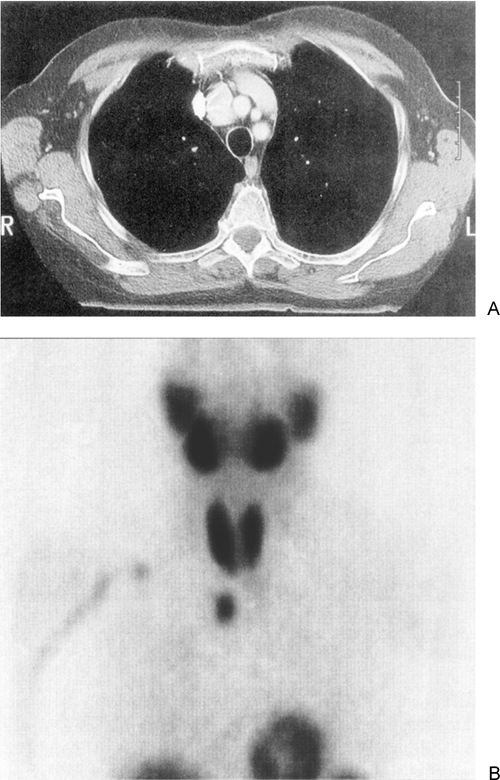 |
Fig. 168-2. A. Computed tomography of the chest demonstrating high-attenuation mass within the superior mediastinum (pretracheal space) between the right subclavian vein and brachiocephalic artery. B. Sestamibi thyroid scan demonstrating a normal cervical thyroid gland with separate uptake in the right upper mediastinum at the site of the mediastinal mass. From Grondin SC, Buenaventura P, Luketich JD: Thoracoscopic resection of an ectopic intrathoracic goiter. Ann Thorac Surg 71:1697, 2001. |
Ectopic Thyroid Tissue Present in the Wall of the Ascending Aorta
Taylor (1986) and Williams (2002) and their associates each have described the rare occurrence of ectopic thyroid tissue present on the wall of the ascending aorta. The first was an autopsy observation and the second was discovered during a cardiac procedure. The thyroid tissue was easily dissected off the wall of the aorta. Postoperatively, studies revealed normal thyroid function. As noted, ectopic tissue associated with the heart and great vessels is most often seen in the interventricular septum at the right ventricular outflow tract, although at times the left outflow tract is involved.
Pathology
In the 1940s through the 1960s, most reported intrathoracic goiters were nontoxic multinodular goiters. Occasionally, a toxic goiter was present. In Katlic and associates' (1985) report of 80 substernal thyroid lesions seen from 1976 through 1982, only 51% were multinodular goiters; 44% were follicular adenomas and 5% were Hashimoto's thyroiditis. Of the follicular adenomas, 23 were classified as simple, 4 as fetal, 2 as colloid, and 2 as embryonal; 3 were H rthle cell lesions.
An occult papillary thyroid carcinoma occasionally may be found in the resected specimen of a substernal goiter. Wakeley and Mulvany (1940) and Katlic and associates (1985) reported an incidence of 2% to 3%. Dahan and colleagues (1989) reported an incidence of 5%. Rodriguez (1999), Shai (2000), and Makieff (2000) and their associates recorded incidences of 4%, 5.3%, and 1.4%, respectively. On the other hand, Allo and Thompson (1983) and Shaha and colleagues (1989a) each recorded an incidence of thyroid carcinoma of 16%. How many cases in these two reports were clinically evident as opposed to occult in nature was not stated. Sanders and colleagues (1992) recorded an incidence of 21%. However, in this series, nine of the malignant lesions, including three cases of a lymphoma involving the thyroid, were clinically significant, and in only two patients (4.6%) was an occult tumor discovered at the time of the excision of the substernal goiter. Torre and co-workers (1995) reported an incidence of 6.7% of cancer in their 237 cases of substernal goiter, but only 3 cases were of the occult type (1.2%). Of the other 13 patients with cancer, most had advanced, obvious clinical malignant disease. Interestingly, even with the high incidence of malignancy reported by Allo and Thompson (1983), these investigators did not recommend preoperative needle biopsy, for they believed that most occult tumors would be inaccessible to random biopsy. As noted, rarely, the thyroid carcinoma may be clinically evident with vocal cord paralysis or tracheal invasion. In these cases biopsy is indicated prior to any final therapeutic decision.
Symptoms and Signs
Most patients with substernal goiters are over 50 years of age, with many in the seventh or eighth decade of life. Women are affected three to four times more often than men. The patients tend to be stout and thick necked. Some degree of kyphosis is not uncommon. A variable number of patients report a history of having undergone one or more previous thyroid operations. In the series of Katlic (1985) and Sanders (1992) and their associates, the incidence was 20%, exclusive of those patients with clinically suspicious malignant lesions. Patients with small extensions of a primarily cervical goiter present with a mass in the neck, and the features are not dissimilar to the complaints and findings in patients with a purely cervical goiter. Patients with partial or complete intrathoracic goiters may be asymptomatic. According to Rietz and Werner (1960), as well as Rieve (1962) and Lamke (1979) and their colleagues, 17% to 32% of the patients with intrathoracic goiters are in this category, and the lesion is only discovered on routine chest radiography. Most patients, however, present with one or more complaints of a cervical mass, dysphagia, dyspnea, stridor, cough or wheezing, and facial flushing. Acute tracheal obstruction with severe respiratory compromise may occasionally be observed. The precipitating event may be obscure, but an acute respiratory infection may play a role. Le Roux and associates (1984) reported that the administration of iodine 131 (131I) may temporarily cause enlargement of the goiter and exaggerate any preexisting tracheal compromise.
P.2505
Acute airway obstruction as reported by Warren (1979) may lead to sudden death; he observed one death in four patients who developed this complication. The management of this emergent event has been discussed in detail by Shaha and associates (1989b); essentially, an adequate airway must be established by intubation and urgent thyroidectomy performed.
Allo and Thompson (1983) reported that some large multinodular substernal goiters may result in incipient or frank thyrotoxicosis because of autonomously functioning hot nodules or because of the total bulk of functioning thyroid mass. In their series, thyrotoxicosis was present in 20% of their 50 patients. Torre and associates (1995) noted an incidence of 13.1%. In many of these patients the thyrotoxicosis was manifested by cardiac failure, by cardiac arrhythmia, or as a wasting syndrome (apathetic thyrotoxicosis). In contrast to this high incidence of thyrotoxicosis, Shaha and associates (1989a) reported in their series that only 1 of 60 patients with benign substernal goiters had thyrotoxicosis, an incidence of 1.6%.
The signs consist of a cervical mass, except for those few patients with a complete intrathoracic goiter or those patients with previous thyroid surgery [over 50% in the series of Ellis and colleagues (1952)], obesity in many, and obvious tracheal deviation in the neck. The cervical mass may move with swallowing. An infrequently encountered goiter, the so-called goitre plongeaut, is one that is normally nonpalpable in the neck but ascends into the area and becomes palpable when the patient coughs, swallows, or performs Valsalva's maneuver. Shocket and Hudson (1957) suggested that hyperextension of the neck during Valsalva's maneuver would facilitate the palpation of such a plunging goiter. Superior vena cava obstruction is seen in a small percentage (1%) of patients, even though almost all intrathoracic goiters are benign lesions. The mechanism of development most often is the compression of the innominate veins and internal jugular veins against the bony margins of the thoracic inlet by the enlarged gland, rather than compression of the superior vena cava per se. The dilated, enlarged veins in the neck have been referred to as Stokes' collar, so named by that Irish physician in the 19th century. Compression of the superior vena cava, however, does occur when it is distorted by a large complete intrathoracic goiter in the anterior mediastinal compartment, as confirmed by Rodriguez and colleagues (1999). The actual incidence is unknown.
In most series, evidence of malignancy has been absent, and the few tumors that have been discovered have been occult in nature. Exceptions do occur, and this has been evident in the series reported by Allo and Thompson (1983) and Sanders and associates (1992) at the Lahey Clinic. Hoarseness caused by a paresis of a vocal cord is a strong indication of the possibility of a malignancy, but it may occur in the presence of a benign lesion as well, so that even though this finding is suggestive of the presence of a malignant tumor, it is not diagnostic.
Rarely, a large substernal goiter may cause a Horner's syndrome, as was recorded by Cengiz and associates (1990). Even the occurrence of a cerebral steal syndrome was observed by Gadisseux and colleagues (1986) in a patient with a large substernal goiter. One of the rarest manifestations recorded was a partial hemidiaphragmatic paralysis due to pressure on one of the phrenic nerves by a recurrent substernal goiter. This case was reported by van Doorn and Kranendonk (1996). Removal of the recurrent substernal goiter results in complete return of normal hemidiaphragmatic function.
Diagnostic Procedures
Standard radiography of the neck and chest is most often diagnostic. CT scans are frequently used when the goiter is a partial or complete intrathoracic goiter, particularly when it is posterior or retrotracheal in location. Radionuclide scintigraphy is also frequently used, and some investigators, such as Park and colleagues (1987), believe it should be used routinely in all suspected cases. Needle biopsy is indicated only infrequently.
Radiographic Features
The standard radiographic finding in most cases is a mass to the right or left of the trachea in the anterior superior portion of the visceral compartment. Tracheal deviation is present in 80% to over 95% of patients. In contrast to other lesions that may cause tracheal deviation within the thorax, characteristically the deviation caused by the goiter begins in the cervical portion of the trachea (Fig. 168-3). Retrotracheal (posterior) goiters may deviate the trachea anteriorly and the esophagus posteriorly (Fig. 168-4).
Retroesophageal goiter displaces the esophagus anteriorly and laterally as well. This is best demonstrated on barium swallow. On lateral radiographs of the chest, the anterior cardiac window remains clear, and a density obscuring this area, which is characteristic of anterior mediastinal compartment tumors [e.g., thymic epithelial tumor (thymoma), lymphoma, or a germ cell tumor], is absent. Calcification within the mass is variable. Katlic and associates (1985) reported only a 3% incidence of calcification; however, most studies, such as those of McCort (1949) and Ellis and colleagues (1952), report much higher incidences of between 25% and 38%. On fluoroscopic examination, movement of the mass may frequently be observed on swallowing.
Computed Tomography
Computed tomography (CT) may reveal additional features to support the diagnosis. Bashist (1983) and Glazer (1982) and their co-workers reported: (a) a clear connection or continuity between the intrathoracic mass and the cervical
P.2506
thyroid gland; (b) well-defined borders; (c) punctate, coarse, or ringlike calcifications in most masses; (d) nonhomogeneity with discrete nonenhancing low-density areas; and (e) prolonged contrast enhancement of the gland with iodinated urographic contrast material. Buckley and Stark (1999) noted that on nonenhanced scans the gland has a higher attenuation (100 Hounsfield units) than the adjacent tissues. With contrast enhancement, the attenuation is increased rapidly and is prolonged well beyond that of any adjacent tissues. Displacement of the trachea and esophagus is especially well demonstrated (Fig. 168-5) in the posterior goiters. This feature was well documented by the aforementioned researchers, as well as by Morris and associates (1982). In addition, with the use of an intravenous contrast bolus, the typical anterolateral displacement of the great vessels is demonstrated readily (Fig. 168-6).
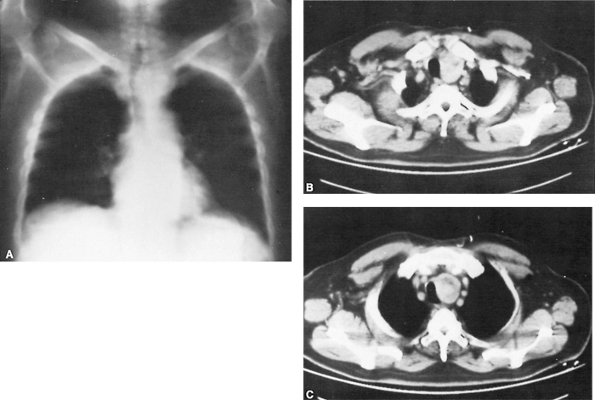 |
Fig. 168-3. A. Posteroanterior radiograph of partial substernal goiter. Note that the deviation of the trachea begins in the neck. B, C. Computed tomographic views show typical displacement of trachea and brachiocephalic vessels. |
Magnetic Resonance
Magnetic resonance (MR) studies of substernal thyroid goiters are usually unnecessary. However, as noted by von Schulthess and associates (1986), MR imaging permits excellent delineation of the great vessels and their relationship to the goiter. This observation was confirmed by Belardinelli and colleagues (1995). The connection to the cervical portion of the thyroid gland can be well demonstrated, as can the inhomogeneity of the mass (Fig. 168-7). Flow voids within the mass as the result of the marked vascularity of the thyroid tissue are of particular diagnostic aid in complete substernal lesions regardless of their location within the mediastinum.
Contrast Studies
Barium swallow may readily demonstrate deviation of the esophagus by a posterior goiter (Fig. 168-8). A vena cavagram may reveal displacement and even occlusion of the innominate and internal jugular veins as they are compressed against the thoracic inlet (Fig. 168-9).
Ultrasonography
The use of ultrasonography in evaluating substernal goiters is not very effective according to Newman and Shaha (1995). However, it can differentiate a cystic lesion such as a parathyroid cyst (see Chapter 197) that is often readily confused clinically as a thyroid lesion.
Thyroid Scintigraphy
Thyroid scintigraphy may be performed with technetium 99m pertechnetate or either 131I or 123I, but this examination
P.2507
has given variable results as reported in the literature. However, Park and colleagues (1987) have shown that with strict attention to the proper techniques, 39 of 42 subsequently proven intrathoracic goiters were appropriately diagnosed by thyroid scintigraphy. These investigators showed that most intrathoracic goiters do have thyroid function, and they suggest that radioiodine scintigraphy is a definitive and cost-effective diagnostic procedure for the disease. Technetium 99m tetrofosmin single-photon emission CT imaging has been shown to enhance substernal thyroid tissue by Ravizzini and associates (2001) as does 99mTc MDP (methylene diphosphonate) as reported by Nourisamie and Konez (2000). Routine imaging, however, is most often executed with 123I compounds, and it is better than the use of 131I according to Buckley and Stark (1999). The pros and cons of the various radionuclides used for thyroid scintigraphy are presented in Chapter 159.
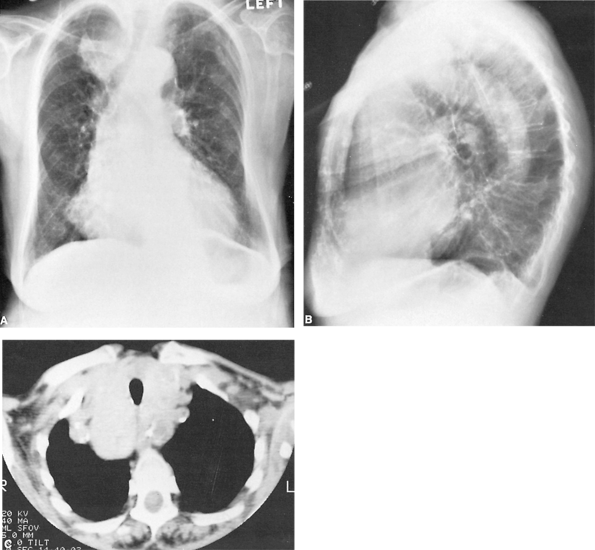 |
Fig. 168-4. Elderly woman with history of previous thyroid surgery with current complaint of dyspnea. A. Posteroanterior radiograph of chest revealing a right paratracheal mass deviation of the trachea slightly to the right. B. Lateral radiograph of chest showing retrotracheal mass distorting the trachea anteriorly and displacing the esophageal air column posteriorly. C. Computed tomographic scan revealing large retrotracheal goiter bilaterally. |
Needle Biopsy
Lamke and colleagues (1979) suggested the use of percutaneous transthoracic needle aspiration biopsy of the suspected goiter to confirm the diagnosis by histologic means. However, except under the most unusual circumstances, this appears to be unnecessary and is not recommended as a part of the diagnostic evaluation. As noted, random biopsy to identify an occult carcinoma is not indicated. However, if a dominant cold nodule is present or if unequivocal findings of malignancy are present, a needle biopsy may be justified. At times in a complete anterior thyroid mass that
P.2508
appears to be ectopic in nature, a diagnostic needle biopsy will yield a diagnosis of a H rthle cell tumor as reported by Mishriki and associates (1983).
 |
Fig. 168-5. Posterior substernal thyroid goiter. A. Typical posteroanterior radiographic appearance. B. Lateral radiograph showing mass in visceral compartment and clear anterior cardiac window area. C. Computed tomographic scan reveals deviation of trachea to the right with lateral and anterior displacement of brachiocephalic vessels. D. Computed tomographic scan shows marked displacement of esophagus to the right and goiter confined by the aortic arch on the left. |
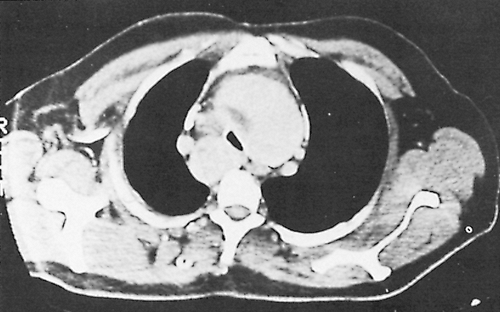 |
Fig. 168-6. Computed tomographic scan of large substernal goiter. Intravenous contrast bolus shows marked compression but no obstruction of great vessels as they are distorted anteriorly and laterally. |
Treatment
The recommended treatment of intrathoracic thyroid goiter is surgical resection. The use of radioactive iodine is contraindicated: Not only may it initially aggravate any preexisting tracheal compression, but as noted by Beierwaltes (1978), radioactive iodine rarely, if ever, alleviates tracheal deviation or compression caused by a large multinodular goiter.
Anesthetic management is best accomplished with an endotracheal tube and general anesthesia. The initial surgical incision is a low transverse collar (thyroid) incision, because
P.2509
over 95% of substernal goiters may be removed through this approach. De Andrade (1977), Wakeley and Mulvany (1940), and Katlic and associates (1985) reported the necessity of only a cervical incision in 95.3%, 100%, and 97.5% of their cases, respectively. Reasons just as, or even more, compelling are that in almost all patients, the blood supply of the intrathoracic goiter is from the inferior thyroid arteries, and injury to the recurrent laryngeal nerve is less likely to occur with this approach. All recent reports, such as those by Torre (1995), Rodriguez (1999), Makieff (2000), and Shai (2000) and their colleagues, agree with this standard approach.
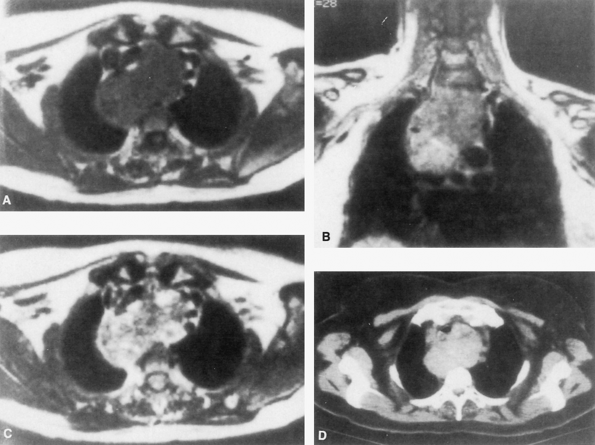 |
Fig. 168-7. Magnetic resonance and computed tomographic scan of substernal goiter. T1-weighted image (A), T2-weighted image (B), and coronal image (C), all showing displacement of vessels anteriorly and laterally with marked inhomogeneity of the mass. D. Conventional computed tomographic scan for comparison. From von Schultness GK, et al: Mediastinal masses: MR imaging. Radiology 158:289, 1986. With permission. |
In those few cases when additional exposure becomes necessary, a partial sternal splint, as initially advocated by Lilienthal (1915), is the procedure used by most thoracic surgeons. However, it is to be noted that in most cases when this is necessary, the great vessels are in front of the intrathoracic goiter (Fig. 168-10). Gourin and associates (1971) suggested a combined cervicomediastinal approach for all partial and complete intrathoracic goiters. This would seem to be totally unnecessary in face of the aforementioned data. In addition, Le Roux and colleagues (1984) stated that they found the use of a sternal split to be of little help in mobilizing the gland that could not be extracted through the standard cervical approach. Rather than a sternal split, Johnston and Twente (1956) advocated that a combined cervicoanterior thoracic approach be used (Fig. 168-11), because they believed a better exposure of the enlarged gland could be obtained by this method. This approach also has been advocated by De Andrade (1977). In addition to the better exposure, gentle upward pressure on the goiter to deliver it into the cervical incision is readily accomplished. A posterior lateral thoracotomy approach, as suggested by Sweet (1949) and subsequently reported by Ellis and co-workers (1952), for posterior intrathoracic goiters is to be avoided if at all possible. Appropriate control of the vascular supply from the neck is difficult at best, and a high incidence of recurrent injury (approximately 27%) has been recorded by Ellis and associates (1952) and others with the use of this approach.
Technically, after exposure of the gland in the neck, the blood supply of the superior pole and the middle thyroid vein are isolated, ligated, and divided. At least one of the superior parathyroid glands should be identified and preserved from harm. The inferior vessels and recurrent nerve are identified, if possible, but at times this cannot be accomplished until the intrathoracic portion of the gland has been delivered from the mediastinum. This is accomplished
P.2510
by finger or pledget dissection within the capsule of the goiter to prevent injury to either the nerve or vessels. Infrequently, as noted, additional exposure is necessary by either a partial upper median sternotomy or a small anterior thoracotomy incision on the appropriate side in the second or third interspace to complete the mobilization. Morcellation of the goiter, as suggested by Lahey (1945), is to be avoided to lessen the possibility of bleeding, which may be difficult to control, and because of the possible presence of an occult carcinoma within the gland. After mobilization of the intrathoracic goiter, the inferior thyroid vessels, if not already controlled, are ligated and divided, and the goiter removed. Collapse of the tracheal wall because of tracheomalacia is feared frequently but is rarely observed. When tracheal obstruction does occur, Allo and Thompson (1983) believe this is more likely the result of kinking of the elongated, distorted trachea. To prevent the occurrence of kinking, they suggest tacking the trachea anteriorly to the strap muscles in the neck before closure of the incision. When tracheomalacia is present, external tracheal support by notched rings as suggested by Geelhoed (1988) is rarely, if ever, necessary. It is a prudent precaution, however, to inspect the tracheal lumen by flexible fiberoptic endoscopy prior to removal of the endotracheal tube; if any narrowing
P.2511
or compromise is suspected, the endotracheal tube should be left in place for 24 to 48 hours postoperatively. Tracheostomy may be indicated if airway obstruction persists. The mediastinal space is drained in all cases to prevent accumulation of fluid within the mediastinum.
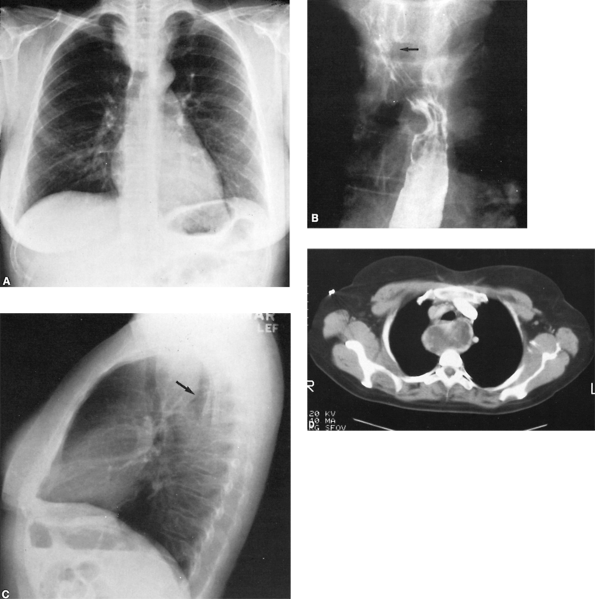 |
Fig. 168-8. Young adult woman with vague symptoms of back pain. No dysphagia or difficulty in breathing; results of physical examination were negative. A. Posteroanterior radiograph of the chest reveals a mass in the superior portion of the mediastinum; no evidence of tracheal deviation. B. Barium swallow reveals distortion of the esophagus to the right (arrow); no obstruction present. C. Left lateral radiograph reveals mass located between the trachea, which is displaced anteriorly, and the esophagus, which is displaced posteriorly (arrow). D. Computed tomographic examination reveals a well-encapsulated mass located posterior to the trachea. On removal the mass was a retrotracheal, substernal thyroid goiter. Courtesy of Joseph LoCicero III, MD. |
 |
Fig. 168-9. Superior vena cavagram showing complete obstruction of the right innominate vein with collateral vessels evident. Distal portion of left innominate vein, also almost completely obstructed at the thoracic inlet in a patient with a superior vena cava syndrome caused by a substernal goiter. Major portion of left innominate vein and superior vena cava are distorted and displaced but widely patent. From Silverstein GE, et al: Superior vena caval system obstruction caused by benign endothoracic goiter. Dis Chest 56:519, 1969. With permission. |
Results
Watt-Boolsen and associates (1981) noted permanent unilateral vocal cord paralysis in 10% of their patients, but whether this was in patients who had undergone a lateral thoracotomy was unstated. This latter approach, as noted, has a high incidence of recurrent nerve injury. Dahan and associates (1989) reported an incidence of recurrent nerve paralyses of 6%. Katlic and associates (1985), on the other hand, reported no instances of vocal cord paralysis in their 80 patients whose surgical management was essentially as described in the section on treatment.
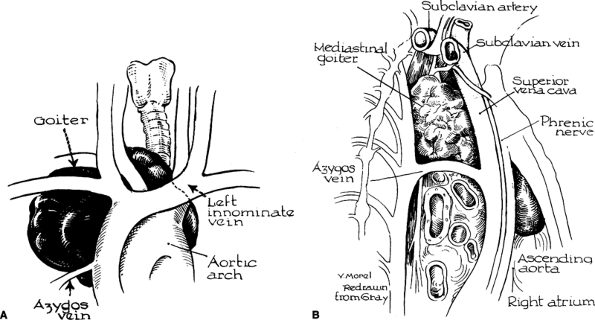 |
Fig. 168-10. Schematic illustration from the frontal and lateral aspects of a partial intrathoracic goiter lying in the visceral compartment of the mediastinum, resting on the border of the vertebrae behind the superior vena cava and the innominate vessels above the azygos vein. From Johnston JH Jr, Twente GE: Surgical approach to intrathoracic (mediastinal) goiter. Ann Surg 143:572, 1956. With permission. |
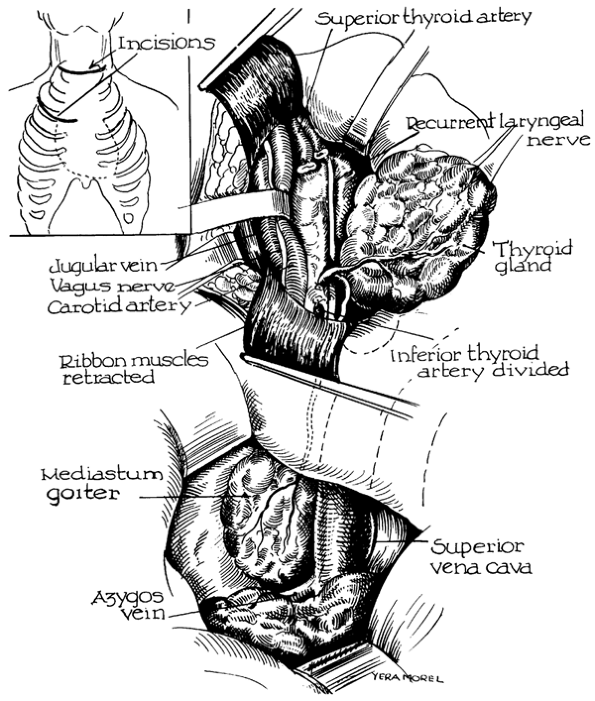 |
Fig. 168-11. Schematic illustration of combined cervicoanterior approach to substernal goiters that cannot be removed through a cervical approach alone. From Johnston JH Jr, Twente GE. Surgical approach to intrathoracic (mediastinal) goiter. Ann Surg 143: 572, 1956. With permission. |
P.2512
Postoperative mortality is rare. De Andrade (1977) reported only 1 death in 128 patients (0.7%) with a partial or complete intrathoracic goiter. Dahan and associates (1989) reported a mortality rate of 2.8%. Most researchers in the literature have reported mortality within the range of these two percentages.
Recurrent substernal goiter is uncommon; this is in contrast to the substantial number of substernal goiters that occur after an earlier removal of a goiter from the cervical area only. Thyroid function is usually normal, as is parathyroid function, as was noted by Watt-Boolsen and colleagues (1981) in their long-term follow-up study.
CERVICOMEDIASTINAL HYGROMA
A cervical cystic hygroma, a form of lymphangioma, is an infrequently encountered congenital anomaly recognized either at birth or in early infancy. It is now even being identified in utero by ultrasonography. These hygromas most frequently arise in the posterior triangle of the neck but may occur in the anterior triangle or midline. These lesions may extend into adjacent fascial compartments. The ipsilateral axilla is involved in approximately 20%. Grosfeld and associates (1982) reported that in 2% to 3% of cases, the hygroma may extend into the mediastinum. Singh and associates (1971) reported a similar incidence of 3%. When this occurs, the hygroma is referred to as a cervicomediastinal hygroma.
Etiology and Anatomy
The cervicomediastinal hygromas are believed to be malformations of the jugular lymphatic sac (Fig. 168-12) and occur as the result of the failure of establishment of appropriate connections to the normally present lymphatic channels. According to Sabin (1910), these connections develop during the sixth to eighth weeks of gestation.
The cervicomediastinal hygroma begins in the neck adjacent to the internal jugular vein near the origin of the nerve roots of C3, C4, and C5. As it enlarges, it descends along the course of the phrenic nerve and enters the visceral compartment of the mediastinum between the subclavian vein and artery in the area of the primitive subclavian lymphatic sac (see Fig. 168-12A). As the hygroma continues to enlarge, it occupies a greater or lesser area of the superior portion of the visceral compartment and may displace or distort the trachea or esophagus, or both. With further growth, it may pass anteriorly over the arch of the aorta to lie in the anterior compartment in the region of the thymus and anterior portion of the pericardial sac (Fig. 168-13). Extension into either hemithorax with compression of the developing lung may occur.
Symptoms and Signs
A cervicomediastinal hygroma is most often discovered at birth by the presence of a mass in the anterior compartment
P.2513
of the neck. The mass is soft and can be transilluminated. A few patients may have respiratory problems at birth caused by hypoxemia, as reported by Csicsko and Grosfeld (1974), but most, other than for the presence of a cervical mass, are initially asymptomatic. However, infection of the hygroma secondary to a respiratory infection, hemorrhage into the cystic mass, or further growth may result in acute respiratory problems caused by compression of the tracheal airway. Other complications such as superior vena cava obstruction or pulmonary atelectasis may rarely occur. Touroff and Seley (1953) reported the occurrence of chylothorax, and Stratton and Grant (1958) reported the occurrence of a chylopericardium with the presence of a cervicomediastinal hygroma.
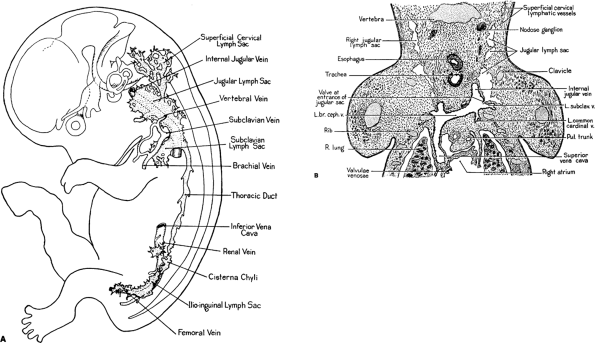 |
Fig. 168-12. A. Lymphatic system of 30-mm human embryo. B. Frontal section of human embryo of 30 mm (beginning in the ninth week) showing entrance of the left jugular lymph sac into the internal jugular vein. Redrawn from Sabin RF: The lymphatic system. In Keibel F, Mall FP (eds.): Manual of Human Embryology. Philadelphia: JB Lippincott, 1912. |
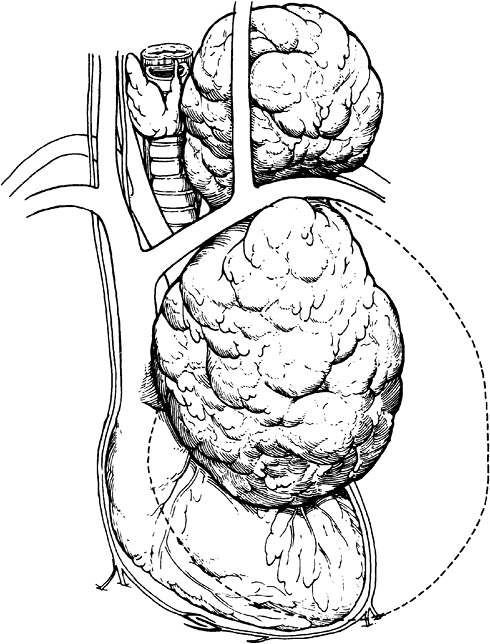 |
Fig. 168-13. Schematic illustration of large cervicomediastinal hygroma descending between the subclavian vein and artery into the anterior mediastinal compartment to lie in front of the aortic arch and anterior portion of the pericardium. Redrawn from Grosfeld JS, Weber TR, Vane DW. One-stage resection for massive cervicomediastinal hygroma. Surgery 92:693, 1982. With permission. |
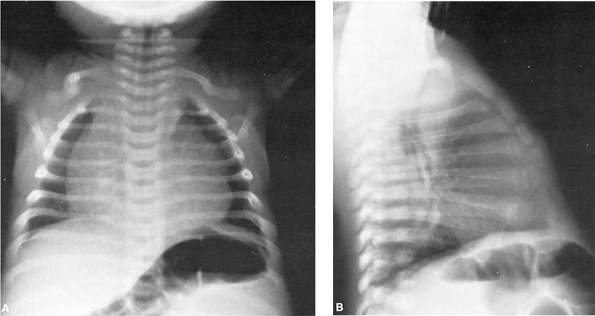 |
Fig. 168-14. Chest radiographs of newborn with extensive cervicomediastinal hygroma. The newborn had symptoms with minor difficulty in breathing. A. Posteroanterior radiograph showing a large mediastinal mass obscuring the heart shadow. B. Lateral radiograph revealing a large mass in the anterior compartment of the mediastinum with deviation of the trachea posteriorly. |
Diagnosis
All newborns with a cystic hygroma of the neck, symptomatic or not, should undergo chest radiography to identify any mediastinal extension if present (Fig. 168-14). Tracheal deviation is present in two thirds of the infants, and esophageal displacement also may be identified. The cystic nature of the mediastinal mass, when present, can be established by ultrasonography. A CT scan is an excellent way to establish the extent of the lesion (Fig. 168-15).
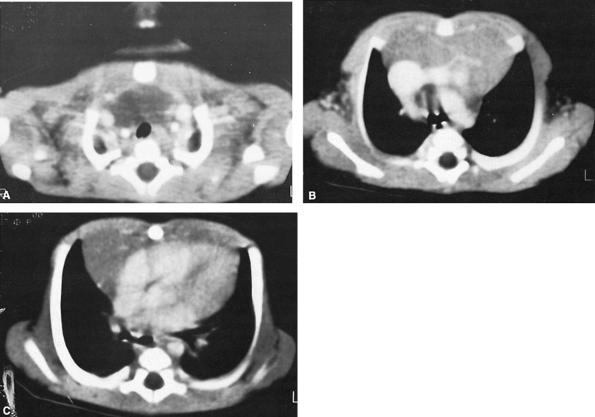 |
Fig. 168-15. Computed tomographic scans of extensive cervicomediastinal hygroma. A. Anterior cystic mass displacing the trachea posteriorly. B. Cystic mass displacing the great vessels posteriorly but no compression seen. C. Mass extending over the anterior aspect of the heart. |
P.2514
Treatment
The only therapy that has been successful is surgical excision. The use of radiation therapy or sclerosing agents is of little or no benefit, and indeed may be harmful. Staged resections, prior to the 1960s, were frequently practiced. However, at present the procedure of choice is a one-stage resection introduced by Kirschner in 1966 and championed by Grosfeld and associates (1982). The procedure may be performed as an emergent, urgent, or elective procedure, depending on the infant's condition (i.e., the presence or absence of respiratory difficulty).
The one-stage resection is performed via an inverted hockey stick incision beginning in the neck and extending down over the sternum (Fig. 168-16), which is split to expose the mediastinal extension of the hygroma. The mass is most often intimately associated with the phrenic, vagus, and recurrent nerves, as well as with the vascular structures within the mediastinum. Care must be used to avoid injury to these structures, but removal of all of the cystic sac when possible is indicated, since regression of the residual hygroma (lymphangioma) does not occur. Radiation therapy is ineffective in obliterating any residual tissue.
Results
With meticulous surgical technique in the removal of the cervical and mediastinal portions of the cervicomediastinal hygroma and appropriate perioperative care, the outlook is excellent. Although a 10% to 15% incidence of recurrence has been reported after the excision of cervical cystic hygromas, recurrence in the mediastinum is exceedingly rare.
CERVICAL MEDIASTINAL CYSTS AND HEMATOMAS
A number of cysts that are identified in the neck extend downward through the superior thoracic inlet into the anterosuperior portion of the visceral compartment, as is observed with the majority of substernal goiters. These, as a general rule, are thymic cysts or parathyroid cysts. Each of these cystic lesions is discussed in Chapter 197. However, an unusual cyst (a cervical mediastinal thymic parathyroid cyst) has been described, as has a major complication (an extracapsular rupture with bleeding from a parathyroid cyst or adenoma with the occurrence of a space-occupying mediastinal hematoma). These deserve further comment.
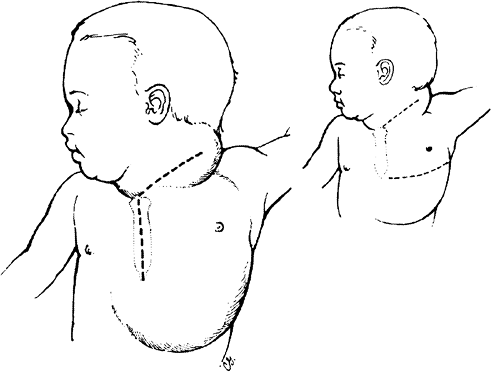 |
Fig. 168-16. Schematic illustration of preferred hockey stick incision for removal of cervicomediastinal hygroma. Insert shows alternate incision for lesions predominantly located in one hemithorax. From Grosfeld JS, Weber TR, Vane DW: One-stage resection for massive cervicomediastinal hygroma. Surgery 92: 693, 1982. With permission. |
P.2515
Cervical Mediastinal Thymic Parathyroid Cyst
Silver (1980) reported a single case of a 9-year-old boy who had a large cervical cyst that descended partially into the anterosuperior, pretracheal, postvascular space, a portion of the visceral compartment of the mediastinum. The cyst was removed without difficulty via a cervical approach. Pathologic examination revealed a cystic mass with well-formed lymph follicles and multiple Hassall's corpuscles in the wall of the cyst. Normal parathyroid tissue was present and intermingled in the cyst wall. A final diagnosis of a congenital thymic parathyroid cyst was made. This diagnostic possibility must be entertained in children with cystic masses in the neck that extend into the mediastinum.
Extracapsular Hemorrhage of a Parathyroid Adenoma or Cyst into the Mediastinum
Extracapsular rupture with hemorrhage into the neck and mediastinum has occurred primarily in patients with cervical parathyroid adenomas or rarely parathyroid cysts. Infrequently, the location of the offending lesion is in the mediastinum, as reported by Berry (1974) and Santos (1975) and their associates. Simcic and colleagues (1989) presented one case of a rupture of a cervical parathyroid cyst and reviewed eight other cases of rupture of either a parathyroid adenoma or cyst. Gamondes and colleagues (1978) reported a hypercalcemic woman who developed an acute marked respiratory distress caused by the development of an extracapsular hemorrhagic cyst from an ectopic parathyroid adenoma in the mediastinum. The cyst in the right upper portion of the anterosuperior mediastinum markedly displaced the trachea to the left. Surgical evacuation of the cyst and removal of the adenoma was curative. Massard and colleagues (1989) also presented a similar case. The common features are hypercalcemia, acute neck swelling, and ecchymosis of the neck, chest, or both. Chest pain, hoarseness, and superior vena cava syndrome are common. The hematoma extends from the neck into the mediastinum, and the mass can be identified readily on radiography as well as CT scans. Appropriate diagnosis, exploration of the neck, evacuation of the hematoma, and excision of the offending adenoma or cyst resolve the issue. The cause of the parathyroid hemorrhage has been suggested by Roma and associates (1985) to be the result of an imbalance between cell growth and blood supply favoring the development of hemorrhagic foci. Infarction and subsequent rupture then may occur.
LESIONS OF THE THORACIC SKELETON
Lesions of the thoracic skeleton that project into the mediastinum are usually bony tumors. Tumors of the sternum are rarely confusing, but posteriorly, chondromas and chondrosarcomas of the heads of the ribs or vertebral bodies may look like mediastinal tumors. Ewing's sarcoma of a rib rarely masquerades as a primary mediastinal tumor.
Thoracic Chordoma
Rarely, a thoracic vertebral chordoma may present primarily as a mediastinal tumor in the paravertebral sulcus or more infrequently in the visceral compartment. These tumors arise from ectopic embryonic remnants of the primitive notochord originally within the axial skeleton. The nucleus pulposus is a normal derivative of this structure; however, chordomas do not occur in the nucleus but do so in the adjacent bone or paravertebral tissues. These tumors are most common at the base of the skull, in the sacrococcygeal region, and within a vertebral body, or rarely in tissues adjacent to it.
According to Rich and associates (1985) in a review of 48 chordomas, 34% originated in a vertebral body. Of these, only three were located in the thoracic spine. Sundaresan and colleagues (1979) reported only two (3.7%) of 54 spinal chordomas to be located in the thoracic portion of the spine. Utne and Pugh (1955) reported an incidence of 1.6% in a collected series of 1,271 cases in the literature at that time. Maesen and associates (1986) noted that most thoracic chordomas occur in the upper thoracic vertebrae, the level of the third or fourth vertebra, although lesions have been reported at both higher and lower levels by Schwartz and colleagues (1985) and other investigators, such as Guerkdjian (1958).
Pathologically, the tumor is grossly a soft, gelatinous mass that may have a thin capsule and usually is connected to one or more vertebral bodies. On microscopic examination,
P.2516
the tumor is made up of cords and sheets of cells surrounded by a mucinous matrix. The characteristic cell has a bubbly, vacuolated, foamy cytoplasm surrounding pyknotic nuclei the so-called physaliphorous or blister-bearing cell (Fig. 168-17). Suster and Moran (1995) reported the immunohistochemical features of six mediastinal chordomas. The tumor cells stained intensely with low-molecular-weight keratin and less intensely with pan keratin, epithelial membrane antigen, and vimentin. Rich and associates (1985) reported that only 2% of these tumors are benign, and the malignant ones show extensive local extension into surrounding tissues and bone.
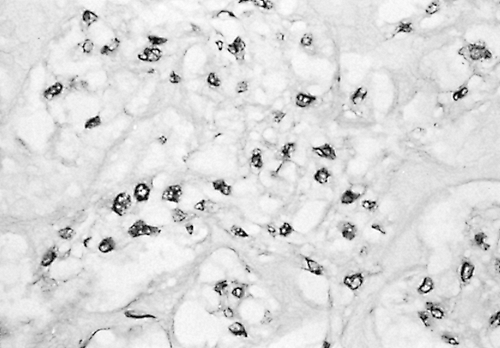 |
Fig. 168-17. Photomicrograph of chordoma with characteristic physaliphorous cells. These cells have a clear cytoplasm with a bubbly appearance (original magnification 250). |
Clinically, the patient may be asymptomatic but usually presents with symptoms related to compression or involvement of adjacent structures. Cury and associates (1997) reported a patient with marked deviation and compression of the trachea by a chordoma that had invaded the superior portion of the visceral compartment. Likewise, Rahman and co-workers (2002) reported a similar occurrence in a patient with a large chordoma arising from the anterior surface of the upper portion of the thoracic vertebral column. Brooks and colleagues (1987) noted that 10% to 43% present with signs or symptoms of spinal cord compression.
Radiographically, the thoracic vertebral chordoma presents as a paravertebral mass or as a mass in the visceral compartment anterior to the vertebral column, displacing the esophagus and trachea anteriorly, as reported by Maesen and associates (1986). Vertebral body destruction may be present on standard radiography. Schwartz and colleagues (1985) reported a rare feature of an ivory vertebra (hyperdensity) on the standard radiographs of a chordoma of an eighth thoracic vertebra.
The diagnosis frequently is suggested by the radiographic and CT findings. Meyer and co-workers (1984) characterized the CT findings in most cases as vertebral body destruction along with an associated soft tissue mass located predominantly anterolateral to the spinal column. Intervertebral disc involvement was noted in only 4 of 25 patients (16%). Amorphous calcification was present in 40% of the lesions studied. Murphy and associates (1998) reported that on MR T2-weighted imaging, septae of low signal intensity may radiate throughout the high-signal mass of the tumor. When present, this feature may be helpful in differentiating a chordoma from other masses in the paravertebral space or anterior to the spine in the posterior portion of the visceral compartment.
Percutaneous needle biopsy may be helpful, but most often the nature of the lesion is not confirmed until biopsy at thoracotomy, especially those located anterior to the vertebral column and apparently not involving a vertebral body.
Treatment is aggressive resection, and although irradiation once was considered of little value, postoperative radiation therapy in doses as high as possible for the tolerance of surrounding structures is recommended. It has been suggested that brachytherapy is better for this purpose. The role of chemotherapy and hyperthermia in these tumors is unknown.
The outlook for these patients is grave. Fewer than 10% of all patients with chordomas survive 5 years. The prognosis is probably worse in those patients with lesions located in the thoracic region, because most, if not all, such tumors can only be incompletely excised. The average survival is slightly more than 2 years, but slower progression of the disease may be noted. Levowitz and colleagues (1966) reported a patient who had survived more than 9 years, although the patient had extensive recurrent disease at the time of their report.
Chondrosarcoma of the Thoracic Spine
Chondrosarcoma arising from a vertebral body and extending into a paravertebral sulcus or into the visceral compartment is rare. Marchevsky and Kaneko (1992) recorded a case of myxoid chondrosarcoma arising from a thoracic vertebra, and Pescarmona and colleagues (1989) reported a similar case. In the latter patient, the mass appeared to be a dumbbell tumor involving the fifth to seventh thoracic vertebra with extension into the involved intervertebral foramina. Radical excision was performed, but no long-term follow-up was given. Takeuchi and associates (1994) reported three cases of chondrosarcoma arising in a costal head or a thoracic vertebral body. Radical resection was attempted in two of the patients, but both died of local recurrence. It would appear that surgical resection at present is of questionable value in this disease in the thoracic spinal region.
Paravertebral Abscess
Infrequently, a tuberculous paravertebral abscess resembles a mediastinal mass on examination, but the associated bony and intervertebral disc destruction, as well as the clinical course of the patient, should lead to the appropriate diagnosis. Bosch and colleagues (1989) presented a patient
P.2517
with the typical aforementioned radiographic findings (Fig. 168-18). Treatment consists of drainage of the abscess and appropriate antituberculous chemotherapy.
 |
Fig. 168-18. A, B. Posteroanterior and lateral chest radiographs revealing a paravertebral mass in the midthoracic region on the right in a patient with back pain. C. Tomogram of spine revealing marked lytic changes involving T7, T8, and T9 vertebral bodies. Intervertebral disc destruction noted between the involved vertebrae. Diagnosis was Mycobacterium tuberculosis of the spine with paravertebral abscess. From Bosch X, et al: Posterior mediastinal mass in a black patient with back pain. JAMA 262:1373, 1989. With permission. |
LESIONS OF THE MENINGES
Anterior Meningocele
Infrequently, a lesion that presents in a paravertebral sulcus is an anterior meningocele, more properly called a lateral meningocele, from the spinal canal. Fewer than 100 cases have been reported. The lesion is frequently asymptomatic and is readily confused with a primary neurogenic tumor. Almost all of the patients are young to middle-aged adults, and the ratio of men to women is approximately equal.
The lesion is a greater or lesser protrusion of the spinal meninges through one or more intervertebral foramina. The majority (85%) are seen in patients with neurofibromatosis (von Recklinghausen's disease). Approximately 10% are either multiple or bilateral. Most patients are asymptomatic, and the paravertebral mass is discovered only on routine chest
P.2518
radiography. However, Miles and associates (1969) reported that back or intercostal pain may be present in 23% of patients, and varying neurologic abnormalities in 17%. Cough and dyspnea, or both, occur in less than 10% of patients.
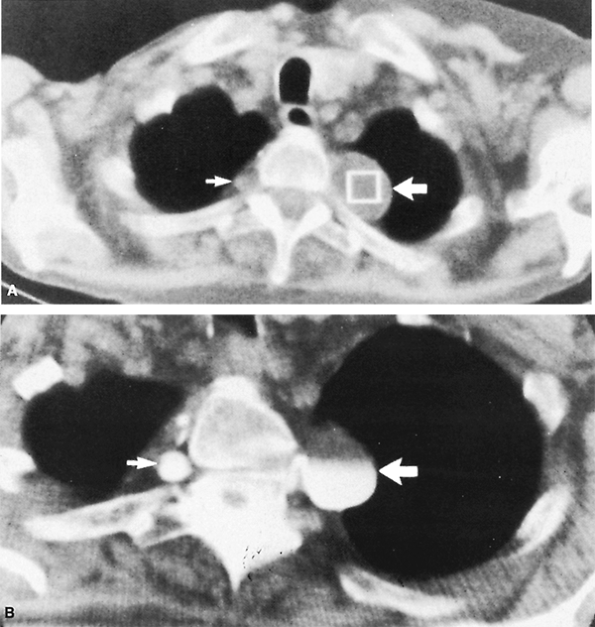 |
Fig. 168-19. A. Computed tomographic scan of bilateral superior paravertebral masses (arrows). B. Computed tomographic metrizamide myelography confirms the diagnosis of bilateral anterior meningocele; note fluid level in the large lesion on the left (arrows). From Weinreb JC, et al: CT metrizamide myelography in bilateral intrathoracic meningoceles. J Comput Assist Tomogr 8:324, 1984. With permission. |
Eighty-five percent of patients with an anterior (lateral) meningocele associated with von Recklinghausen's disease have kyphoscoliosis at the site of the lesion. Erkulvrawatr and co-workers (1979) have discussed the association between these two lesions.
Edeiken and colleagues (1969) outlined the radiographic features as a well-defined lateral paraspinal mass. As noted, kyphoscoliosis is often present. Scalloping of the adjacent dorsal vertebra, enlargement of the intervertebral foramen, pedicle erosion, or splaying or thinning of adjacent ribs may be apparent.
CT examination is essential to discover the cystic nature of the lesion (low density, and subsequently a low Hounsfield number) and to delineate the vertebral body involvement. If doubt as to the nature of the paravertebral mass remains, CT metrizamide myelography can be used to confirm the diagnosis, as reported by Weinreb and associates (1984) (Fig. 168-19).
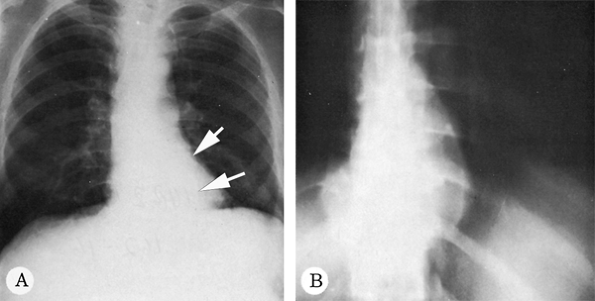 |
Fig. 168-20. A. Posteroanterior radiograph of chest showing an ill-defined mass (arrows) behind the heart on the left. B. Laminograms showing bilateral nature of the ectopic hematopoietic tissue. From Drake CT, et al. Ectopic hematopoietic tissue masquerading as a mediastinal tumor. Ann Thorac Surg 1:743, 1965. With permission. |
Surgical resection is not indicated if the diagnosis is known. If resection is performed, secure closure of the neck of the meningocele, as pointed out by Ya Dean and colleagues (1965), to prevent a spinal fluid leak into the pleural space is absolutely necessary. When considerable loss of bony support is evident, posterior spinal fusion is recommended by Kornberg and colleagues (1984).
OTHER MASQUERADING LESIONS
Intrathoracic Extramedullary Hematopoiesis
Ectopic extramedullary hematopoietic tissue may occur rarely in the thorax. Catinella and associates in 1985 reported that fewer than 35 examples of this had been reported in the literature as of that date, but the actual number of cases is undoubtedly somewhat greater. With rare exception, the ectopic tissue is located inferiorly in one or both of the paravertebral sulci. In the patient reported by Catinella and associates (1985), the ectopic tissue was located in the anterior compartment just beneath the dorsal surface of the
P.2519
sternum. The ectopic hematopoietic tissue almost always accompanies a severe form of hemolytic anemia, such as a hereditary spherocytic anemia, thalassemia, sickle cell anemia, or pernicious anemia.
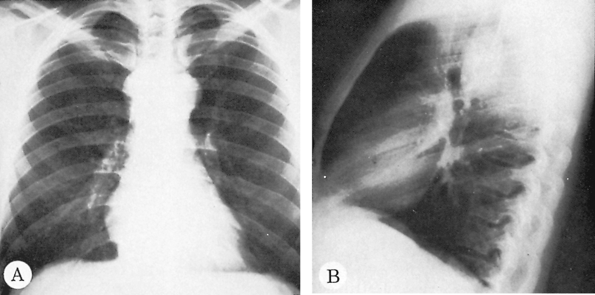 |
Fig. 168-21. A. Posteroanterior radiograph of chest showing mediastinal enlargement projecting to the right of the aorta. B. Lateral radiograph reveals the mass to be in the visceral compartment. Subsequent studies and resection revealed the mass to be a large leiomyoma of the esophagus. |
Radiographically, the ectopic tissue appears as an inferior paraspinal mass, but on CT examination or laminography, the mass may be shown frequently to be bilateral (Fig. 168-20). Papavasiliou and associates (1982) have described the CT features. The hematopoietic nature of the mass at times may be confirmed by radionuclide studies as suggested by Drake and colleagues (1965). Either radioactive iron (59Fe) or radioactive gold (198Au) if available, may be used to establish that the mass is composed of hematopoietic elements. Percutaneous needle aspiration or biopsy may be performed if the diagnosis is in doubt.
Once the diagnosis is established, unless evidence exists of intraspinal canal extension with compression of the spinal cord as described by Lowman (1963), Sorsdahl (1964), and Luyendijk (1975) and their colleagues, therapy of any sort is unnecessary. In fact, because this tissue may be the only functioning hematopoietic tissue, surgical excision or radiation therapy to reduce the mass is contraindicated unless other functioning tissue can be identified elsewhere in the body. However, with findings of spinal cord compression, radiation therapy is indicated; Dietz and associates (1985) reported complete remission of spinal cord compression in one of their patients following irradiation.
Lesions of Vascular Origin
Mediastinal masses of vascular origin must be differentiated from true mediastinal tumors. These masses may be either arterial or venous in origin and may arise from either the systemic or pulmonary systems. The normal vascular anatomy and the various congenital anomalies and disease states of these structures must be kept in mind when a mediastinal mass is encountered radiographically (see Chapter 169). Angiography, radionuclide flow studies, and CT are useful in establishing the diagnosis. MR imaging is valuable in evaluating a suspected vascular abnormality, because of the imaging characteristics of blood-filled structures.
Lesions of the Esophagus
A few lesions of the esophagus, such as the severe sigmoid type of achalasia, epiphrenic diverticulum, esophageal duplications, large leiomyoma (Fig. 168-21), and large extramural spread or a contained perforation of an esophageal carcinoma may appear as mediastinal tumors on initial radiographic studies of the chest (Fig. 168-22). Barium studies of the esophagus, endoscopy, and manometric studies may help establish the appropriate diagnosis. Surgical treatment should be performed as indicated.
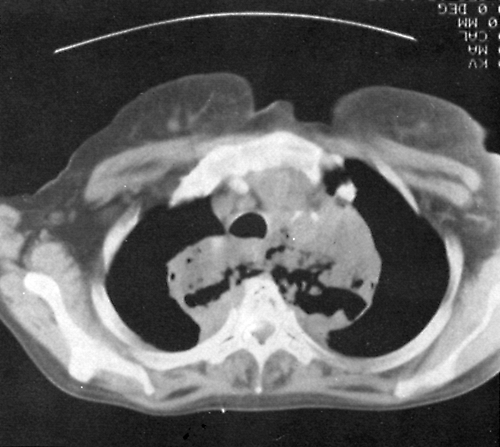 |
Fig. 168-22. Spontaneous contained perforation of a carcinoma of the esophagus simulating a large mediastinal mass. Computed tomographic scan revealed pockets of air within the mass. Perforation was confirmed by barium swallow and endoscopy. |
P.2520
Lesions of the Lungs
Tumors of the lung, both benign and malignant, may be confused with mediastinal tumors. Occasionally, an extralobar sequestration may be initially thought to be a mediastinal tumor. Appropriate studies, including CT and MR imaging as necessary, establish the diagnosis. Angiography may be necessary on infrequent occasions. The diagnosis should rarely be made only at thoracotomy.
LESIONS ORIGINATING BELOW THE DIAPHRAGM
Esophageal Hiatal Hernias
Hernias through the esophageal hiatus posteriorly may initially simulate a mediastinal tumor or cyst. Any one of the four types of esophageal hiatal hernias may appear as a retrocardiac mass in the visceral compartment. Although vastly less frequent in overall incidence, the more common ones presenting in this manner are types II, III, and IV as defined by Baue and Naunheim (1989). Barium studies readily resolve the issue.
Foramen of Morgagni Hernias
Foramen of Morgagni hernias may be confused with any of the varieties of the so-called anterior cardiophrenic angle lesions. As my colleagues and I (1962) reported, these may include mesothelial cysts, most often a pleuropericardial cyst, thymoma, benign germ cell tumor, lipoma, or rarely diaphragmatic tumor, or as noted previously, complete substernal thyroid goiter. Appropriate barium studies and CT examination should resolve the problem in most instances.
Pancreatic Pseudocysts
Infrequently, a pancreatic pseudocyst may present as a mass in the visceral compartment behind the heart. Johnston and colleagues (1986) reviewed this subject and presented an example of this unusual complication of pancreatic disease. The clinical presentation should alert one to the possibility that the retrocardiac mass is a pseudocyst. Confirmation is best obtained by CT of the chest and abdomen, which demonstrates the extension of the cyst from the abdomen into the chest. Treatment is by internal drainage of the cyst through a laparotomy approach.
REFERENCES
Allo MD, Thompson NW: Rationale for operative management of substernal goiters. Surgery 94:969, 1983.
Bashist B, Ellis K, Gold RP: Computed tomography of intrathoracic goiters. AJR 140:455, 1983.
Baue AE, Naunheim KS: Paraesophageal hiatal hernia. In Shields TW (ed): General Thoracic Surgery. 3rd Ed. Philadelphia: Lea & Febiger, 1989.
Baykut D, et al: Ectopic thyroid tissue in the left ventricular outflow tract. Ann Thorac Surg 69:620, 2000.
Beierwaltes WH: The treatment of hyperthyroidism with iodine 131. Semin Nucl Med 8:95, 1978.
Belardinelli L, et al: Comparison between computed tomography and magnetic resonance data and pathologic findings in substernal goiters. Int Surg 80:65, 1995.
Berry BE, et al: Mediastinal hemorrhage from parathyroid adenoma simulating a dissecting aneurysm. Arch Surg 108:740, 1974.
Bosch X, et al: Posterior mediastinal mass in a black patient with back pain. JAMA 262:1373, 1989.
Brooks M, et al: Thoracic chordoma with unusual radiographic features. Comput Radiol 11:85, 1987.
Buckley JA, Stark P: Intrathoracic mediastinal thyroid goiter: imaging manifestations. AJR 173:471, 1999.
Casanova JB, et al: Intrathoracic ectopic thyroid. Ann Thorac Surg 70: 1694, 2000.
Catinella FP, Boyd AD, Spencer FC: Intrathoracic extramedullary hematopoiesis simulating anterior mediastinal tumor. J Thorac Cardiovasc Surg 89:580, 1985.
Cengiz K, et al: Intrathoracic goiter with hyperthyroidism, tracheal compression, superior vena cava syndrome and Horner's syndrome. Chest 97:1005, 1990.
Cove H: The mediastinum. In Coulson WF (ed): Surgical Pathology. 2nd Ed. Philadelphia: JB Lippincott, 1988.
Creswell LL, Wells SA Jr: Mediastinal masses originating in the neck. Chest Surg Clin North Am 2:23, 1992.
Csicsko JF, Grosfeld JL: Cervicomediastinal hygroma with pulmonary hypoplasia in the newly born. Am J Dis Child 128:557, 1974.
Cury JD, et al: Tracheal deviation from an atypical mediastinal mass. Chest 111:503, 1997.
Dahan M, Gaillard J, Eschapasse H: Surgical treatment of goiters with intrathoracic development. In Delarue NC, Eschapasse H (eds): International Trends in General Thoracic Surgery. Vol. 5. Thoracic Surgery: Frontiers and Uncommon Neoplasms. St. Louis: CV Mosby, 1989.
De Andrade MA: A review of 128 cases of posterior mediastinal goiter. World J Surg 1:789, 1977.
Dietz R, et al: Zur Radiotherapie der durch extramedull res h matopoetisches Gewebe bedingten Paraplegien. Strahlentherapie 161:140, 1985.
Dosch F: Uber einen Fall von Glandula thyreoidea accessoria intracardialis. Beitr Pathol Anat 105:244, 1941.
Drake CT, et al: Ectopic hematopoietic tissue masquerading as a mediastinal tumor. Ann Thorac Surg 1:742, 1965.
Dundas P: Intrathoracic aberrant goiter. Acta Chir Scand 128:729, 1964.
Edeiken J, Lee KF, Libshitz H: Intrathoracic meningocele. Am J Roentgenol Radium Ther Nucl Med 106:381, 1969.
Ellis FH Jr, Good CA, Seybold WD: Intrathoracic goiter. Ann Surg 135:79, 1952.
Erkulvrawatr S, et al: Intrathoracic meningoceles and neurofibromatosis. Arch Neurol 36:577, 1979.
Gadisseux P, et al: Cerebrovascular circulation steal syndrome secondary to a voluminous retrotracheal goiter. Int Surg 71:107, 1986.
Gamondes JP, et al: Ad nome parathyro dien du m diastin sup rieur avec kyste h matique suffocant. Nouv Presse Med 7:4149, 1978.
Geelhoed GW: Tracheomalacia from compressing goiter: management after thyroidectomy. Surgery 104:1100, 1988.
Gilmour JR: The embryology of the parathyroid glands, the thymus and certain associated rudiments. J Pathol 45:507, 1937.
Glazer GM, Axel L, Moss AA: CT diagnosis of mediastinal thyroid. AJR 138:495, 1982.
Gourin A, Garzon AA, Karlson KE: The cervicomediastinal approach to intrathoracic goiter. Surgery 69:651, 1971.
Grondin SC, Buenaventura P, Luketich JD: Thoracoscopic resection of an ectopic intrathoracic goiter. Ann Thorac Surg 71:1697, 2001.
Grosfeld JS, Weber TR, Vane DW: One-stage resection for massive cervicomediastinal hygroma. Surgery 92:693, 1982.
Guerkdjian SA: Chordoma of the dorsal spine. Can J Surg 2:106, 1958.
Hall TS, et al: Substernal goiter versus intrathoracic aberrant thyroid: a critical difference. Ann Thorac Surg 46:684, 1988.
P.2521
Houck WV, et al: Intrathoracic aberrant thyroid: identification critical for appropriate operative approach. Am Surg 64:360, 1998.
Jaretzki A III, Wolff M: Maximal thymectomy for myasthenia gravis. Surgical anatomy and operative technique. J Thorac Cardiovasc Surg 96:711, 1988.
Johnston JH Jr, Twente GE: Surgical approach to intrathoracic (mediastinal) goiter. Ann Surg 143:572, 1956.
Johnston RH Jr, et al: Pancreatic pseudocyst of the mediastinum. Ann Thorac Surg 41:210, 1986.
Katlic MR, Grillo HC, Wang CA: Substernal goiter. Analysis of 80 patients from Massachusetts General Hospital. Am J Surg 149:283, 1985.
Kirschner PA: Cervicomediastinal cystic hygroma: one-stage excision in an eight-week-old infant. Surgery 60:1104, 1966.
Kornberg M, Rechtine GR, Dupuy TE: Thoracic vertebral erosion secondary to an intrathoracic meningocele in a patient with neurofibromatosis. A case report. Spine 9:821, 1984.
Lahey FH: Intrathoracic goiters. Surg Clin North Am 25:609, 1945.
Lamke LO, Bergdahl L, Lamke B: Intrathoracic goitre: a review of 29 cases. Acta Chir Scand 145:83, 1979.
Le Roux BT: Heterotopic mediastinal thyroid. Thorax 16:192, 1961.
Le Roux BT, Kallichurum S, Shama DM: Mediastinal cysts and tumors. Curr Probl Surg 21:1, 1984.
Levowitz BS, et al: Thoracic vertebral chordoma presenting as a posterior mediastinal tumor. Ann Thorac Surg 2:75, 1966.
Lilienthal H: A case of mediastinal thyroid removed by transsternal mediastinotomy. Surg Gynecol Obstet 20:589, 1915.
Lowman RM, Bloor CM, Newcomb AW: Roentgen manifestations of thoracic extramedullary hematopoiesis. Chest 44:154, 1963.
Luyendijk WH, Went L, Schaad H: Spinal cord compression due to extramedullary hematopoiesis in homozygous thalassemia. J Neurosurg 42:212, 1975.
Maesen F, et al: Chordoma of the thorax. Eur J Respir Dis 68:68, 1986.
Makieff M, et al: Les goitres plongeauts. propos de 212 cas. [Substernal goiter. Report of 212 cases.] Ann Chir 125:18, 2000. [article in French]
Marchevsky AM, Kaneko M: Surgical Pathology of the Mediastinum. 2nd Ed. New York: Raven, 1992.
Massard JL, et al: H morragie cervico-m diastinale r v latrice d'un adenome parathyro dien. Nouv Presse Med 18:1524, 1989.
McCort JL: Intrathoracic goiter: its incidence, symptomatology, and roentgen diagnosis. Radiology 53:227, 1949.
Meissner WA, Warren S: Tumors of the thyroid gland. In The Atlas of Tumor Pathology. Second Series, Fascicle 4. Washington, DC: Armed Forces Institute of Pathology, 1969.
Meyer JE, et al: Chordomas: their CT appearance in the cervical, thoracic and lumbar spine. Radiology 153:693, 1984.
Miles J, Pennybacker J, Sheldon P: Intrathoracic meningocele. Its development and association with neurofibromatosis. J Neurol Neurosurg Psychiatry 32:99, 1969.
Mishriki YY, et al: Hurthle-cell tumor arising in the mediastinal ectopic thyroid and diagnosed by fine needle aspiration. Light microscopic and ultrastructural features. Acta Cytol 27:188, 1983.
Morris UL, et al: CT demonstration of intrathoracic thyroid tissue. J Comput Assist Tomogr 6:821, 1982.
Murphy JM, et al: CT and MRI appearance of a thoracic chordoma. Eur Radiol 8:1677, 1998.
Newman E, Shaha AR: Substernal goiter. J Surg Oncol 60:207, 1995.
Nourisamie K, Konez O: Calcified substernal goiter seen on bone scan. Clin Nucl Med 25:725, 2000.
Nwafo DC: Heterotopic mediastinal goitre. Br J Surg 65:505, 1978.
Papavasiliou C, et al: The CT findings of extramedullary hematopoiesis. Radiologe 22:86, 1982.
Park HM, et al: Efficacy of thyroid scintigraphy in the diagnosis of intrathoracic goiter. AJR 148:527, 1987.
Pescarmona E, et al: Myxoid chondrosarcoma of the mediastinum. Appl Pathol 7:318, 1989.
Polvani GL, et al: Intracardiac ectopic thyroid: conservative surgical treatment. Ann Thorac Surg 55:1249, 1993.
Rahman AM, et al: Giant mediastinal chordoma. Ann Thorac Surg 73: 1952, 2002.
Ravizzini GC, et al: Detection of a large substernal goiter during Tc-99m tetrofosmin cardiac SPECT imaging. J Nucl Cardiol 8:421, 2001.
Rich TA, et al: Clinical and pathologic review of 48 cases of chordoma. Cancer 56:182, 1985.
Rietz KA, Werner B: Intrathoracic goitre. Acta Chir Scand 119:379, 1960.
Rieve TS, et al: The investigation and management of intrathoracic goitre. Surg Gynecol Obstet 115:223, 1962.
Rodriguez JM, et al: Substernal goiter: clinical experience of 72 cases. Ann Otol Rhinol Laryngol 108:501, 1999.
Rogers W: Anomalous development of the thyroid. In Werner SC, Ingbar SH eds. The Thyroid. 5th Ed. New York: Harper & Row, 1978.
Rogers WM, Kesten HD: Embryologic bases for thyroid tissue in the heart. Anat Rec 142:323, 1962.
Roma J, et al: Spontaneous parathyroid hemorrhage in a hemodialysis patient. Nephron 39:66, 1985.
Sabin RF: The lymphatic system. In Keibel F, Mall FP (eds.): Manual of Human Embryology. Philadelphia: JB Lippincott, 1912.
Sabin FR: The lymphatic system in human embryos with a consideration of the morphology of the system as a whole. Am J Anat 9:43, 1910.
Sackett WR, et al: Thyrothymic thyroid rests: incidence and relationship to the thyroid gland. J Am Coll Surg 195:635, 2002.
Salvatore M, Gallo A: Accessory thyroid in the anterior mediastinum: case report. J Nucl Med 16:1135, 1975.
Sand J, et al: Pulsating mass at the sternum: a primary carcinoma of ectopic mediastinal thyroid. J Thorac Cardiovasc Surg 112:833, 1996.
Sanders LE, et al: Mediastinal goiters. The need for an aggressive approach. Arch Surg 127:609, 1992.
Santos GH, Tseng CL, Frater RW: Ruptured intrathoracic parathyroid adenoma. Chest 68:844, 1975.
Schwartz SS, et al: Thoracic chordoma in a patient with paraparesis and ivory vertebral body. Neurosurgery 16:100, 1985.
Shaha AR, Alfonso AE, Jaffe BM: Operative treatment of substernal goiters. Head Neck 11:325, 1989a.
Shaha AR, et al: Goiters and airway problems. Am J Surg 158:378, 1989b.
Shai S-E, et al: Surgical management of substernal goiter. J Formos Med Assoc 99:827, 2000.
Shields TW: Primary tumors or cysts of the mediastinum. In Shields TW (ed): General Thoracic Surgery. Philadelphia: Lea & Febiger, 1972, p. 931.
Shields TW: Lesions masquerading as primary mediastinal tumors or cysts. In Shields TW (ed): Mediastinal Surgery. Philadelphia: Lea & Febiger, 1991, p. 118.
Shields TW: Thyroid. In Pearson FG, et al (eds): Thoracic Surgery. New York: Churchill Livingstone, 1995, p. 454.
Shields TW, Lees WM, Fox RT: Anterior cardiophrenic angle tumors. Q Bull Northwestern Univ Med School 36:363, 1962.
Shocket E, Hudson TR: Plunging goiter made evident by Valsalva's maneuver. Arch Surg 75:135, 1957.
Silver WE: Cervical mediastinal thymic parathyroid cyst. Otolaryngol Head Neck Surg 88:403, 1980.
Silverstein GE, et al: Superior vena caval system obstruction caused by benign endothoracic goiter. Dis Chest 56:519, 1969.
Simcic KJ, et al: Massive extracapsular hemorrhage from a parathyroid cyst. Arch Surg 124:1347, 1989.
Singh S, Baboo ML, Pathak IC: Cystic lymphangioma in children: report of 32 cases including lesions at rare sites. Surgery 69:947, 1971.
Sorsdahl OS, Taylor PE, Noyes WD: Extramedullary hematopoiesis mediastinal masses, and spinal cord compression. JAMA 189:343, 1964.
Spinner RJ, et al: Thoracic intrathymic thyroid. Ann Surg 220:91, 1994.
Stratton VD, Grant RN: Cervicomediastinal cystic hygroma associated with chylopericardium. Arch Surg 77:887, 1958.
Sundaresan N, et al: Spinal chordomas. J Neurosurg 50:312, 1979.
Sussman SK, Silverman PM, Donnal JF: CT demonstration of isolated mediastinal goiter. J Comput Assist Tomogr 10:863, 1986.
Suster S, Moran CA: Chordomas of the mediastinum: clinicopathologic, immunohistochemical, and ultrastructural study of six cases presenting as posterior mediastinal masses. Hum Pathol 26:1354, 1995.
Sweet RH: Intrathoracic goiter located in the posterior mediastinum. Surg Gynecol Obstet 89:57, 1949.
Takeuchi S, et al: Chondrosarcoma in costal head or vertebral body: a report of three cases. J Jpn Assoc Chest Surg 8:845, 1994.
Tang AT, et al: Thoracic intrathymic thyroid and cervical goiter: single-stage resection. Ann Thorac Surg 74:578, 2002.
Taylor MA, Bray M, Roberts WC: Aberrant thyroid gland attached to ascending aorta. Am J Cardiol 57:708, 1986.
Torre G, et al: Surgical management of substernal goiter: analysis of 237 patients. Am Surg 61:826, 1995.
P.2522
Touroff AS, Seley GP: Chronic chylothorax associated with hygroma of the mediastinum. J Thorac Cardiovasc Surg 26:318, 1953.
Utne JR, Pugh DG: The roentgenologic aspects of chordoma. Am J Radiol 74:593, 1955.
van Doorn LG, Kranendonk SE: Partial unilateral phrenic nerve paralysis caused by a large intrathoracic goitre. Neth J Med 48:216, 1996.
von Schulthess GK, et al: Mediastinal masses: MR imaging. Radiology 158:289, 1986.
Wakeley CPG, Mulvany JH: Intrathoracic goiter. Surg Gynecol Obstet 70: 702, 1940.
Warren CPW: Acute respiratory failure and tracheal obstruction in the elderly with benign goitres. Can Med Assoc J 121:191, 1979.
Watt-Boolsen S, et al: Surgical treatment of benign nontoxic intrathoracic goiter. A long-term observation. Am J Surg 141:721, 1981.
Weinreb JC, et al: CT metrizamide myelography in bilateral intrathoracic meningoceles. J Comput Assist Tomogr 8:324, 1984.
Williams RJ, Lindop G, Butler J: Ectopic thyroid tissue on the ascending aorta: an operative finding. Ann Thorac Surg 73:1642, 2002.
Willis RA: The Borderland of Embryology and Pathology. London: Butterworths, 1962.
Ya Dean RE, Clagett OT, Divertie MB: Intrathoracic meningocele. J Thorac Cardiovasc Surg 49:202, 1965.
EAN: 2147483647
Pages: 203
- Chapter III Two Models of Online Patronage: Why Do Consumers Shop on the Internet?
- Chapter V Consumer Complaint Behavior in the Online Environment
- Chapter VI Web Site Quality and Usability in E-Commerce
- Chapter IX Extrinsic Plus Intrinsic Human Factors Influencing the Web Usage
- Chapter XVII Internet Markets and E-Loyalty